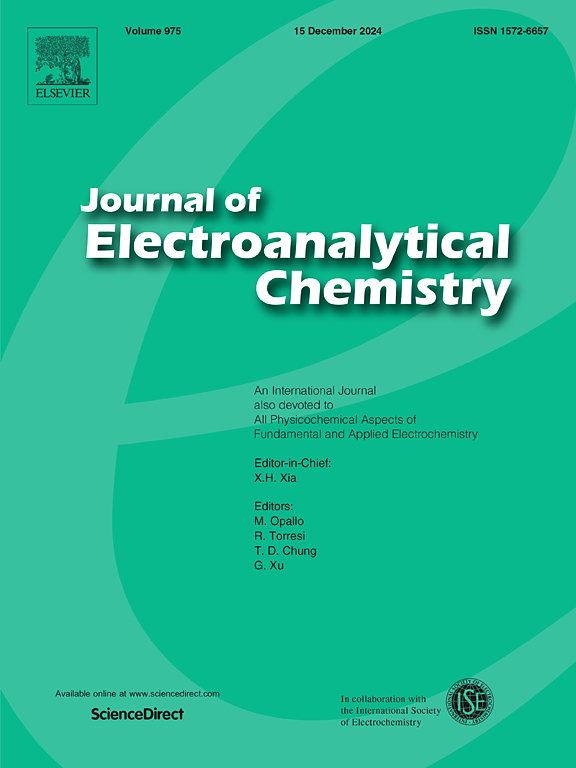High performance in water splitting(OER) mediated by porphyrin coupled with Polyoxometalates in COF: A breakthrough in electrocatalysis
IF 4.1
3区 化学
Q1 CHEMISTRY, ANALYTICAL
引用次数: 0
Abstract
The advancement of water–splitting technologies and renewable energy systems necessitates the development of robust and efficient electrocatalysts for the oxygen evolution reaction (OER). Covalent organic frameworks (COFs) based on metal-free porphyrins and polyoxometalates (POMs), demonstrate exceptional electrocatalytic performance for OER, offering a sustainable approach for efficient oxygen generation. In this study, an innovative COF (TTCMPP–POM) was synthesized by integrating TTCMPP and POM unites through straight forward condensation process. The hybrid material synergistically combines the catalytic and electronic properties of POM known for their stability and high OE activity, with the electron donating and redox flexible capabilities of porphyrins. Comprehensive spectroscopic and microscopic analyses confirmed the stability and structure of the TTCMPP–POM (COF). Electrochemical investigations revealed the superior OER performance of TTCMPP–POM (COF), which exhibited a lower overpotential (404 mV) at 10 mAcm−2 compared to TTCMPP (415 mV), POM (503 mV), and RuO2 (394 mV). Furthermore, TTCMPP–POM (COF) achieved an impressive Tafel slope of68.84 mVdec−1, out performing TTCMPP (88.45 mVdec−1), POM (142.18 mVdec−1), and RuO2 (134.62 mVdec−1). Electrochemical impedance spectroscopy (EIS) and electroactive surface area (ECSA) analyses confirmed enhanced charge transfer properties of TTCMPP–POM (COF). These results establish TTCMPP–POM (COF) as a highly effective and modular electrocatalyst, paving the way for its applications in renewable energy technologies.

卟啉偶联多金属氧酸盐在COF中的高效水分解(OER):电催化的一个突破
随着水分解技术和可再生能源系统的发展,需要开发出稳定高效的析氧反应电催化剂。基于无金属卟啉和多金属氧酸盐(pom)的共价有机框架(COFs)在OER中表现出优异的电催化性能,为高效产氧提供了一种可持续的方法。本研究将TTCMPP和POM单元通过直接正向缩合工艺进行整合,合成了一种新型COF (TTCMPP - POM)。该杂化材料将POM的催化性能和电子性能(以其稳定性和高OE活性而闻名)与卟啉的供电子和氧化还原柔性能力协同结合。综合光谱和显微分析证实了TTCMPP-POM (COF)的稳定性和结构。电化学研究表明,与TTCMPP (415 mV)、POM (503 mV)和RuO2 (394 mV)相比,TTCMPP - POM (COF)在10 mAcm−2下表现出较低的过电位(404 mV)。此外,TTCMPP - POM (COF)的Tafel斜率为68.84 mVdec−1,优于TTCMPP (88.45 mVdec−1)、POM (142.18 mVdec−1)和RuO2 (134.62 mVdec−1)。电化学阻抗谱(EIS)和电活性表面积(ECSA)分析证实TTCMPP-POM (COF)的电荷转移性能增强。这些结果表明TTCMPP-POM (COF)是一种高效、模块化的电催化剂,为其在可再生能源技术中的应用铺平了道路。
本文章由计算机程序翻译,如有差异,请以英文原文为准。
求助全文
约1分钟内获得全文
求助全文
来源期刊
CiteScore
7.80
自引率
6.70%
发文量
912
审稿时长
2.4 months
期刊介绍:
The Journal of Electroanalytical Chemistry is the foremost international journal devoted to the interdisciplinary subject of electrochemistry in all its aspects, theoretical as well as applied.
Electrochemistry is a wide ranging area that is in a state of continuous evolution. Rather than compiling a long list of topics covered by the Journal, the editors would like to draw particular attention to the key issues of novelty, topicality and quality. Papers should present new and interesting electrochemical science in a way that is accessible to the reader. The presentation and discussion should be at a level that is consistent with the international status of the Journal. Reports describing the application of well-established techniques to problems that are essentially technical will not be accepted. Similarly, papers that report observations but fail to provide adequate interpretation will be rejected by the Editors. Papers dealing with technical electrochemistry should be submitted to other specialist journals unless the authors can show that their work provides substantially new insights into electrochemical processes.

 求助内容:
求助内容: 应助结果提醒方式:
应助结果提醒方式:


